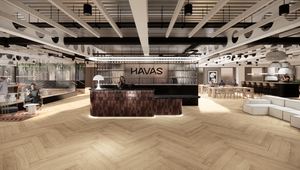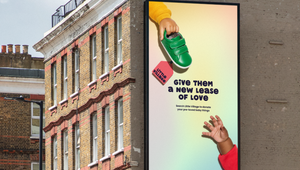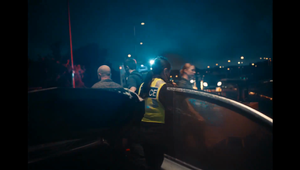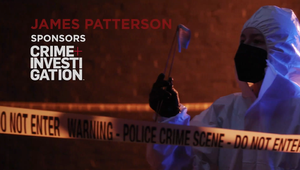
How Asda Hired Buddy the Elf for Christmas

Christmas magic is what the world needs in times of trouble, and Christmas magic is exactly what the world got from the newest Asda campaign, in which audiences were amazed by the sight of Buddy the Elf in the middle of an Asda shop, looking for a new job. Created by Havas London, with post production by Framestore, the campaign brings the classic film back to life in modern day times by using original footage from Elf, by reprising iconic lines from the film. The Christmas-loving character Buddy, under licence from Warner Bros. Discovery Global Consumer Products, finds himself in the best place to be around the holidays - Asda - where he tries everything he can think of to become their new seasonal recruit.
Paying homage to the 2003 movie, the spot opens with Elf’s iconic ‘street crossing’ scene, but instead of a New York City cab, Buddy bumps into a train of Asda shopping trolleys. Following the initial crash, we go through a rollercoaster of adventures, from a catastrophic trial shift for Buddy, through to his subsequent hiring, after which he dashes enthusiastically out of the store, running into the same train of shopping trolleys, as the line ‘Have your Elf a Merry Christmas’ shows up on the screen.
The striking spot proves to be a threefold challenge - firstly, the deal brokering and Hollywood badgering over Buddy’s licensing, then the sheer creative challenge of providing a narrative that fits a character from 20 years back, into a modern shopping experience, and last but not least, the compositing and VFX process that seamlessly blended Buddy in Asda.
As this was the very first time Elf has been licensed for brand marketing, the process was extremely difficult for the masterminds from Born Licensing and Talent Republic, who led the way. Born Licensing were the ones who managed the licensing of the Elf IP, which included the character Buddy along with original footage from the film, phrases, and iconography. David Born, CEO of Born Licensing says, “When Havas first shared the concept, we knew it would be a challenge. Elf is one of the most popular Christmas films of all time, and rights holders are extremely protective of IP that is as cherished as this.”
Having worked with Elf Rights Holder Warner Bros. on a number of projects previously (including Uber and Tesco) – in addition to David having worked at Warner Bros. for four years prior to launching Born Licensing – they knew the concept had to be presented in the right way. “It helped that it was us presenting it to Warner Bros., because we were able to address what we knew their concerns would be from the outset. We helped them understand the creative ambition and reassured them that their valuable IP was in safe hands with Born Licensing, Vicki Maguire, Danny Kleinman and their teams.”
But this isn’t the end of that story - getting the Elf rights holders comfortable was only ‘half the battle’, as Anne Batz, founder and CEO of Talent Republic puts it. Theirs was the honour of presenting the opportunity to Will Ferrel and getting him on board. “Since Talent Republic first opened its doors in 2006, there have been numerous calls about the idea of reviving Buddy, and the response was always a very polite ‘no’,” says Anne.
However, for the past year, Talent Republic had been working with Will and his team on developing a partnership with Nordic challenger bank, Lunar, which helped with the request being considered more seriously this time. “Nevertheless, when we heard it was a tentative ‘maybe’, we were still taken aback - clearly the fact Will was not expected to don his yellow tights helped,” comments Anne. Working with Will was also a good reason for the creative to be ‘extraordinarily brilliant’ and for enormous reverence to be paid to the original IP.
With a campaign as big as this one, once the deal was agreed upon, the work was ‘only just getting started’. To stay true to the Buddy character and Elf brand, all campaign material had to be submitted to both Warner Bros. and Will’s team for review, in an efficient manner and under tight timings. “Despite the punishing schedule and sheer volume of materials,” continues Anne, “The amazing act is that the overall process on the talent and IP side was pretty smooth, as every party involved played to the top of their game and wholeheartedly embraced the ambition. This now makes the tide of praise that much sweeter, more gratifying and is clearly well deserved.”
When it comes to the creative side of things, Dan Cole, creative director at Havas London, explains that the original brief called for something that would put a genuine smile on the face of the nation, and the agency knew they had to go all out. “When Elf came up as an idea, there wasn’t a lot to argue with. He loves Christmas more than anyone, he’s eternally optimistic, funny, cheeky…and he’s Asda green! Asda felt the same when we presented it as a wild card idea - but none of us seriously believed we’d get permission to do it. Still can’t,” says Dan.
Sam Daly, associate creative director at Havas, explains that what the team really wanted to capture was the excitement that comes with Christmas, which is something that Buddy represents better than anyone. “Culturally, the character is so loved by so many people, that it was just about making sure we didn’t try to force him into any situation that didn’t fit. The story had to work around him and while it was difficult writing the script, I think letting Buddy just be Buddy was the key.” This brings us to the second major challenge of the campaign, the creative one.
Andy Garnett, creative director at Havas, says that the script had to fit Buddy into an entirely new narrative for him, that made sense of “Asda’s exuberant festive joy” but did not doctor a single piece of footage from the original film. “No deep faking, body part swapping, all that. The number of times we all watched the movie would stretch all the way to the North Pole and back. The process became almost scientific at times,” continues Andy. “It forced our brains into the most complex jigsaw we’d ever done at Christmas. The most fun part, though, was seeing a 6’2 elf fling himself at a 20-foot Christmas tree. That will always be funny.”
On Asda’s side of things, there was a lot of interest in how the supermarket supports its people and communities, coming from both Will himself and Warner Bros. Things like the £1 meal deals for kids and OAPs throughout the winter, as well as the initiatives including cost-of-living grants to help support community groups facing increasing rent and bills, were all topics of discussion that proved the genuine commitment of the brand. “Because we knew Will had turned down stupid money to make Elf 2, and he and director Jon Favreau were very protective over Buddy, we wanted to show that we had nothing but good intentions for the UK’s favourite Christmas character,” says Dan Cole. “We were pretty much tested on our love for Buddy - and had to say why he’d make such a great Asda colleague. We committed to treating the whole production with the respect it deserves.”
Then came the third challenge of the creation of the campaign - the process of putting Buddy into the ad itself. Kamen Markov, creative director at Framestore, says that the commercial posed a unique hurdle. “Rarely - if at all - do you see the main character of a 90-second commercial taken entirely from old footage and ingested into newly filmed material.”
Kamen explains that the difficulty comes from not having any camera information at all. “The colours and the grading are already baked in the picture, the footage is not prepared and filmed ready to be keyed. Additionally, you have the lovely 35mm film stock quality that needs to now be reapplied to the news footage or removed from the film source.” The process required a very different approach with a huge dollop of planning prior to the shoot.
According to Kamen, everything started with an edit of the film material taken by VFX and analysed in detail. The first thing the team then did, was to extract lens and camera information - lens, height, movement, distance to Buddy, etc. Following this, Framestore did a full digital light detection and ranging (LiDAR) scan of one of the Asda flagship stores. LiDAR is a remote sensing method that uses light in the form of a pulsed laser to measure variable distances to the Earth. Then, VR company The Third Floor built a rudimentary CG layout, which was virtually scouted by director Danny Kleinman and the creatives at Havas, to choose the location for each and every shot.
This process helped the team at Framestore to generate a full-length pre-visualisation of the edit. “We started immediately cutting out Buddy from the film footage to optimise time,” says Kamen. “This was a monumental task on its own, with Will Ferrell having this lovely curly hair and the costume having a slightly fluffy texture, which required extremely detailed rotoscoping.” The key to the shoot though, reveals Kamen, was the lighting. “No amount of good edge work will overcome bad matching in light. For that reason, working very closely with our DoP Ben Smithard, we shot a body double in Buddy’s costume for each shot. This not only provided context for framing of the shots and the supporting talent, but was essential for the compositing team to have a spot-on reference of how the light works with the body and face shapes.”
Following this meticulous work was the balancing of the film, and creating bespoke LUTs, which are files that allow basic colour grading work to be transferred from Baselight to the compositing software. Then this was used as the in-between look, to help the initial process of matching the film material to the newly filmed digital material. After the shoot, a matching grading pass was done for the digital footage. Only once the selection of the backplates was approved, the compositing team was ready to begin their work.
“One not-so-obvious aspect of the task in hand was the number of set extensions we needed to do alongside the integration of the film footage,” says Kamen. “As we needed to have control of the space, time and light, we chose to shoot the Asda interior as a studio build instead of using a real location. This meant we didn’t have the scale and depth of a real shop and there was a fair bit of blue screen keying and digital extension done in post-production.”
This provided a couple of challenges to overcome, for instance, Buddy appearing too small in the frame versus what the team wanted his size to be. Scaling it up only softened the image and ruined the shot, so Framestore trained a machine-learning model in order to generate missing pixels.
“In simple words,” adds Kamen, “the biggest challenge of all of this was to make it believable across the whole film. The king is the story, the dialogue, and the performance. For that to work, sometimes Buddy is taken from a small, confined place and composited in a brightly lit wide one. It was the creative decisions done right in unison with the huge number of technical solutions performed at the same time. Developing a fidelity of the final picture that works as one. For that reason, I am very happy we managed to remove the traditional ‘distance’ between the compositing and grading teams and work as one crew at all stages, from start to finish. I couldn’t be prouder of the artists for their work and dedication to this project.”
Kamen explains that Framestore, as well as the other teams involved in the project, all understood the pressure that came with using such an iconic film for the first time ever, not only because of the high expectations that the British public puts on Christmas advertising, but also because they all needed to do justice to the character of Buddy and the Elf brand. Kamen concludes, “In an era of deep fake, it was a breath of fresh air to stay authentic. It was an invaluable learning experience, and we look forward to what creative minds can do with this type of technique in the future.”















